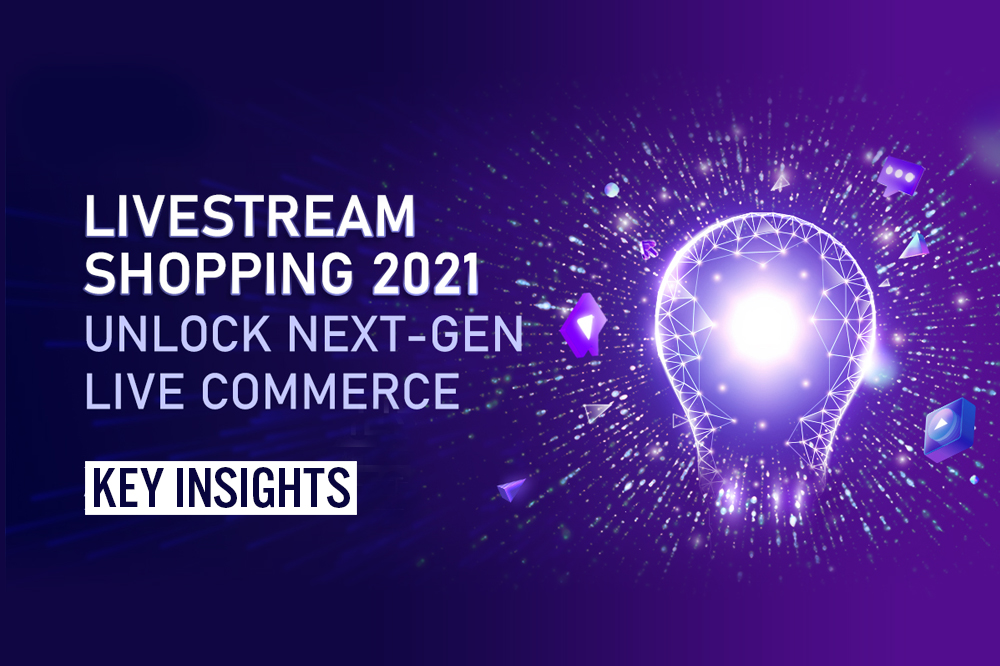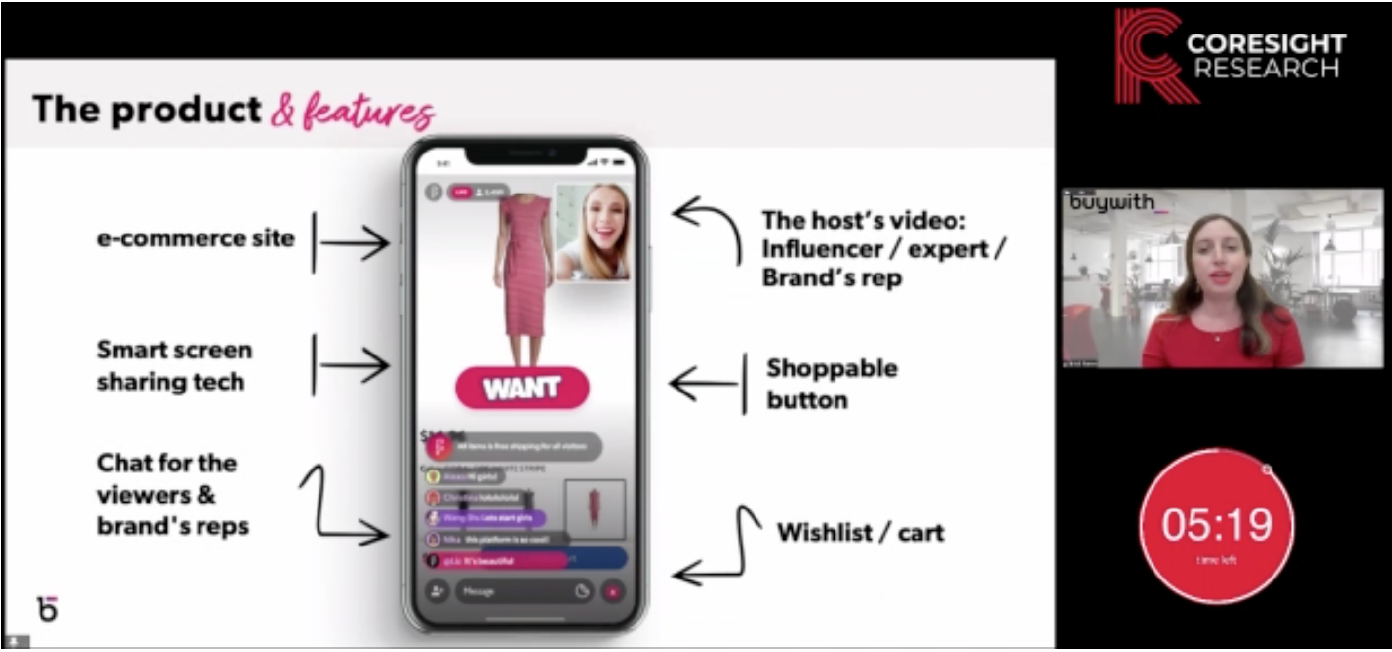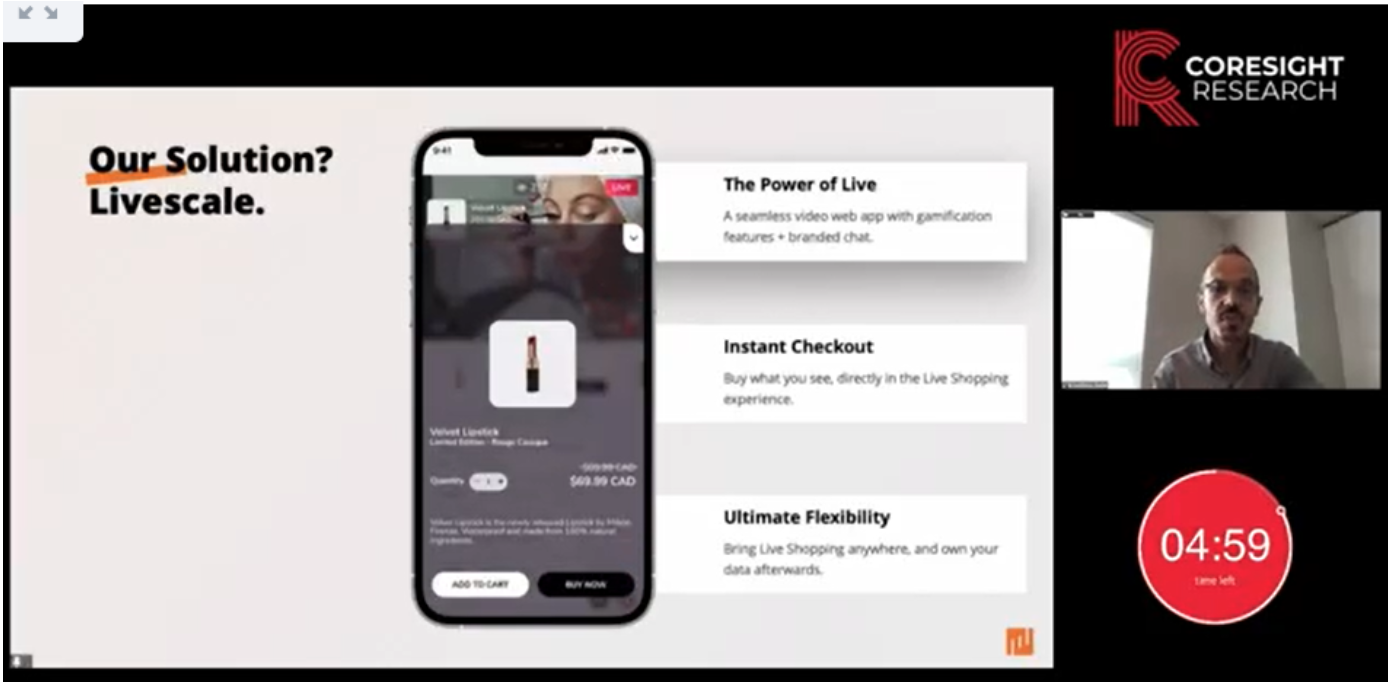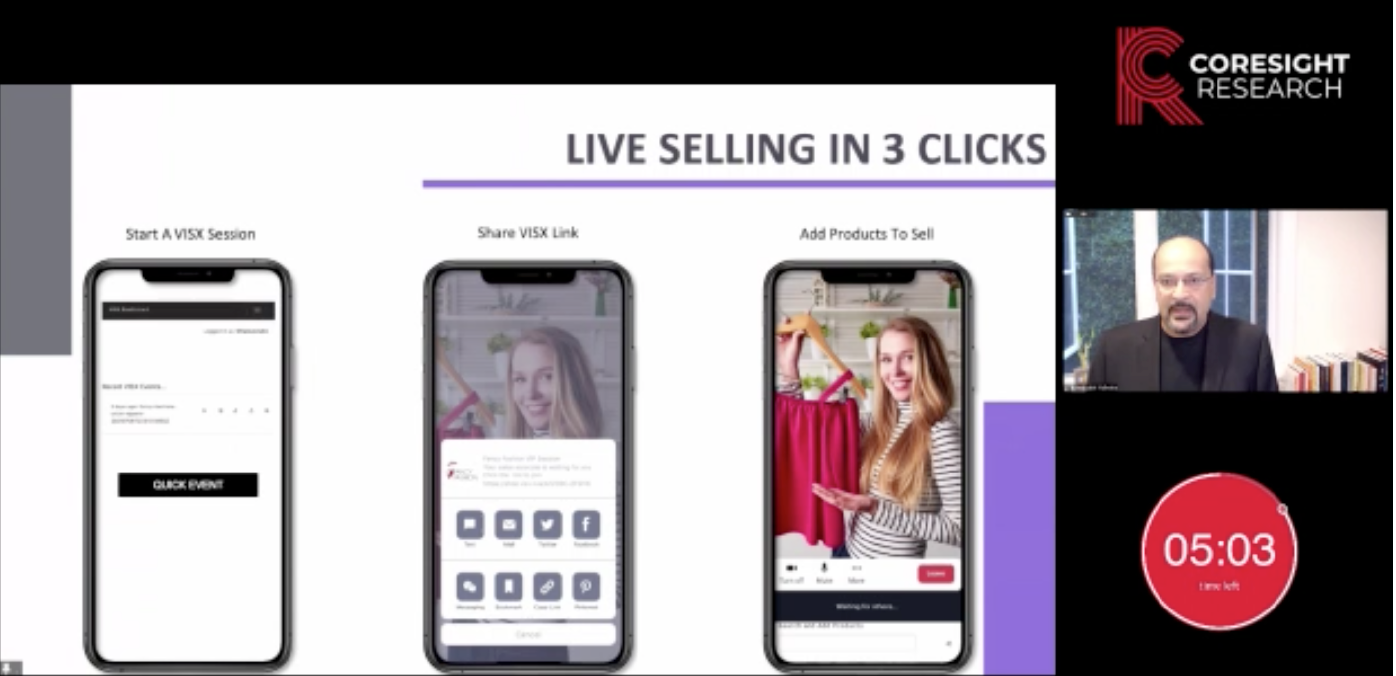
albert Chan
Livestream Shopping 2021: Five Competing Startups, Five Myths Busted and Five Panel Insights
Coresight Research has identified livestreaming e-commerce as one of the key trends to watch in retail. We project that the US livestreaming e-commerce market will total $11 billion in 2021 and grow to $35 billion by 2024.
Our Livestreaming Shopping 2021 conference brought together VIPs, decision-makers, influencers and technology providers in the livestreaming space to provide insight into the uses and future of this e-commerce innovation.
The conference was sponsored by Gerber Technology, a Lectra company, and end-to-end omnichannel gifting solution GiftNow. It comprised a pitch session, a fireside chat on livestream myth busing and two panel discussions exploring key technologies and themes in the livestreaming e-commerce space.
The Pitch Session
Five technology innovators presented their livestreaming e-commerce solutions for the next generation of livestreaming.
- Buywith: A startup offering a live shopping solution for brands, retailers and content creators to host live virtual shopping events with minimal onboarding
- LiSA: A livestream shopping tech company with a community-led retail focus
- Livescale: A multi-platform integrated solutions provider for livestream shopping
- Quidol: A startup providing interactive livestream solutions targeted at both individuals and large businesses
- VISX by Omnyway: A retail-technology company that helps brick-and-mortar stores integrate live commerce
Each of the startups had three minutes to present and two minutes for a Q&A session with the judges. The event was judged by the following retail thought leaders:
- Carlos Alberini—CEO of Guess? Inc.
- Ken Harrell—Co-Founder and Senior Managing Director of asset management company Pharus
- Oren Paran—Managing Director of retail leadership organization Retail Innovation Club
- Sarah Williams—Brand Educator and Spokesperson at hairstyling brand T3
We profiled the five startups in a separate report prior to the event. Below, we detail highlights from their presentations, in the order in which they presented.
Buywith
During the presentation Adi Ronen, CEO and Founder of Buywith touted the accessibility of the company’s livestreaming offering, which is facilitated by its patented unique smartscreen sharing technology, “Shop With Me.” She explained that this technology “allows the host to navigate from product to product [and] give recommendations in real-time,” as the user experience is based on the e-commerce site itself.
Ronen highlighted to the judges that Buywith allow brands, retailers and content creators to host events without integration, professional equipment or in-app downloads. In addition, the platform provides users with multi-host options and customizable designs to promote strong brand interactions and community building.
[caption id="attachment_131798" align="aligncenter" width="700"] Buywith’s pitch presentation
Buywith’s pitch presentationSource: Buywith/Coresight Research[/caption]
LiSA
Sophie Frères, Co-Founder and CEO of LiSA explained that the company is centered on the belief that the future of retail is community-led, rather than consumer centric. As such, the company’s livestreaming strategy is based on “consumers’ desire for social interaction, an increased need for curation and discovery and desire for authentic entertainment.” Frères explained to the judges that LiSA has found that “user-generated content is up to five times more effective in creating sales conversion than brand-created content,” and thus aims for the company’s community to drive content creation LiSA’s platform.
[caption id="attachment_131799" align="aligncenter" width="700"] LiSA’s pitch presentation
LiSA’s pitch presentationSource: LiSA/Coresight Research[/caption]
Livescale
Geoffroy Robin, Chief Executive of Sales and Marketing at Livescale, presented the company’s three core livestream offerings: live video services, integrated checkout and a shared livestreaming experience. The platform allows users to share livestreaming links across many websites and social media sites to boost engagement.
Robin explained to the judges that the company’s live video functionality, such as a customizable dashboard and enhanced gamification options, allows users to “stand out through their videos.” He highlighted that its seamless checkout integration is highly beneficial in “allowing consumers to make purchases without leaving the video experience.”
Stating that livestreams on the Livescale platform are “easy to share across multiple websites and social media,” Robin pointed out that the company’s offering facilitates an easy simulcast experience to boost livestream reach. Robin stated that Livescale uses both integrated and embedded livestreaming to give merchants full control over the look and feel of their live shopping experiences, in addition to an integrated e-commerce system that allows brands and retailers to handle orders in real time.
[caption id="attachment_131800" align="aligncenter" width="1388"] Livescale’s pitch presentation
Livescale’s pitch presentationSource: Livescale/Coresight Research[/caption]
Quidol
Sergine Dupuy, Founder and President of Quidol, explained to the judges that Quidol provides full-service solutions for large businesses as well as a self-service options to enable any brand, seller or influencer to benefit from live selling. She believes that “entertainment is key for engagement and revenue generation” and thus highlighted the interactive layer of Quidol’s platform, which is equipped with live chats and polls and “looks like a modern and engaging TV show.”
Quidol focuses on supporting the user experience through adaptable technology, allowing users to watch livestreams on any device and livestreamers to simulcast across social media sites. Depuy stated that Quidol’s capacity to “synchronize up to 300,000 live shows” has made the platform “available to anyone.”
[caption id="attachment_131801" align="aligncenter" width="700"] Quidol’s pitch presentation
Quidol’s pitch presentationSource: Quidol/Coresight Research[/caption]
VISX by Omnyway
Amitaabh Malhotra, Chief Operating Officer and Co-Founder of VISX by Omnyway, explained to the judges that the company integrates livestreaming with brick-and-mortar retail, enabling store associates to host livestreaming sessions and boost sales. VISX by Omnyway focuses on creating a “true omnichannel livestreaming experience” that takes into account the unique circumstances of both physical and online stores, such as accessing a client book or store inventory issues, and create solutions for both.
Malhotra discussed the platform’s three distinct products: Visx Direct, for VIP or small regional streams; Visx Live, a general livestreaming service; and Visx media, a platform that displays shoppable content. The platform is user friendly and can be set up with just three clicks, providing a full control dashboard with a detailed custom view for inventory management and pricing.
[caption id="attachment_131802" align="aligncenter" width="700"] VISX by Omnyway’s pitch presentation
VISX by Omnyway’s pitch presentationSource: Omnyway/Coresight Research[/caption]
The Winner
Michael Cantrell, Sales Development Lead at GiftNow, announced Livescale as the winner of the competition and congratulated Geoffroy Robin on his presentation. Livescale will receive gift cards from GiftNow as a prize.
The Fireside Chat: Busting Five Livestreaming Myths, Helping Retailers Strategize Ahead of Holiday 2021
Coresight Research’s in-house livestreaming experts—Bao Arakov, Livestreaming Specialist, and Anna Beller, Director of Special Projects—exposed five common myths about livestreaming to help brands and retailers understand how they can leverage this technology ahead of holiday 2021.
Myth #1: Only big brands can execute livestream shopping
“Businesses of any size can launch live shopping [and] unlock great marketing potential,” Arakov explained. Livestreaming opportunities are not exclusive to established companies. This technology can help businesses to grow at a “faster pace than through traditional processes,” according to Arakov, by targeting and engaging with specific consumer groups.
Emerging beauty brands such as Covey and Beekman 1802 have seen explosive engagement and sales growth on its livestream shopping platform, allowing the company to feel confidence in its live shopping community ahead of the upcoming holidays.
Myth #2: Celebrity livestream hosts are the only way to drive sales conversion
There are multiple ways to interact with consumers through a livestream and drive sales conversion. Coresight Research’s social commerce survey from March 2021 indicates that “47% of consumers follow influencers or celebrities on social media” according to Beller. However, these large audiences “do not always convert to sales.” Beller recommended that brands and retailers use store associates or a brand team with comprehensive product knowledge to answer questions from viewers.
Myth #3: Only beauty and fashion products sell on livestreams
Livestreaming is extremely versatile, allowing for successful sales of items from almost any sector, from electronics to furniture, as explained by Arakov. This year, retailers are increasing the “integration of livestreaming with mixed product selections within one session” according to Arakov.
Our experts pointed to LG Electronics US, which has seen success in livestream sales of kitchen electronics, and Petco, which has turned to the channel to boost pet adoption in the US.
Myth #4: Social media platforms are the most effective selling channel
Although brands and retailers may find success in using social media platforms for livestreaming, it is also beneficial to have an independent livestream site. Walmart has seen success with this approach, simultaneously hosting livestream shopping events on its own commerce site and on TikTok.
Beller explained that the advantages of having an independent site include “the ability to track data and better understand the customer’s journey.” Access to consumer data allows companies to create actionable insights to improve their livestream strategies and boost consumer engagement.
Myth #5: Livestreaming requires a professional studio and video team
The technical requirements for livestreaming are highly accessible, as only a smartphone and good lighting are needed to get started. Arakov explained that “anyone can easily log into their social account and kick off a live shopping session” through sharing functions on their social media accounts. Alternatively, companies looking to tap livestreaming can employ third-party tools to access hosting support, as well as add-on features such as quizzes and coupons, with minimal onboarding. It is therefore possible for small and medium-sized businesses to take advantage of the channel with very little investment in setup.
[caption id="attachment_131804" align="aligncenter" width="700"] Beller (left) and Arakov (right) bust five myths about livestream shopping
Beller (left) and Arakov (right) bust five myths about livestream shoppingSource: Coresight Research[/caption]
The Panel Discussions: The Power of Livestream Commerce
Below, we present five key insights from across our two panel discussions, which explored how brands and retailers can increase market awareness through social media and engage with consumers in the digital age.
Panel 1: Increasing Market Awareness Through Social Media
Host: Deborah Weinswig—CEO and Founder of Coresight Research
Panelists:
- Marie Driscoll—Managing Director of Luxury and Retail at Coresight Research
- Lisa Mason—jewelry designer and former QVC host
- Ric Kostick—CEO and Founder of cosmetics and skincare brand 100% Pure
- Christina Liedtke—Founder and Creative Director of women’s ready-to-wear apparel brand Astouri
- Tyler Marie Shumpert—Owner and Designer of womenswear brand Gladys Tyler
Brands Should Build a Community To Expand Their Reach
Livestreaming is an essential tool for brands and retailers to attract consumers and can be effectively coupled with social media strategies that promote brand and community building. By facilitating an interactive shopping experience, much like QVC shopping, livestreaming is an effective tool in reaching new consumers and building strong community engagement, according to Kostick.
When integrating live selling into social media, Liedtke acknowledges that converting existing followers into customers is a common challenge. It is essential for brands to be able to create a “live shopping space [that] offers the freedom and flexibility for the host,” allowing the livestreamer to sell both “the product [and] their personality,” according to Mason. This helps to reinforce the growth of communities and audiences around a brand.
Panelists discussed the importance of brand storytelling in expanding market reach: Instead of throwing facts, statistics or testimonials at viewers of a livestream session, brands and retailers should focus on making the live presence personal and relatable, with the hosts sharing their own opinions on the product.
Authenticity Is Key for Brands, Retailers and Livestream Hosts
Panelists proposed various strategies for brands and retailers to ensure that their livestreaming marketing is authentic and engaging. Authenticity is vital, explains Liedtke, who views authenticity as “a storyline to get to a consumer’s emotions,” which facilitates purchasing decisions and unites consumers into a community.
The strategies discussed include the following:
- Use people who care about the brand: Driscoll recommended that brands and retailers select hosts “who are passionate about the brand,” such as in-store associates or micro influencers. These hosts can express and communicate a genuine enthusiasm to the audience, which is crucial. Driscoll explained that the livestream shopping format combines the best of online and offline shopping, as it enables both product discovery and an emotional connection.
- Have a regular cadence for livestream sessions: According to Weinswig, “having a regular cadence is [the] best strategy” for brands and retailers trying to find the right balance for scheduling their livestream shopping sessions. Regular live shopping schedules with different themes enable brands and retailers to form new consumer habits. In addition, having a predictable schedule can help brands and retailers to become an ongoing part of their consumers’ lives instead of merely an online shop used for a one-time purchase. When devising their schedules, brands and retailers should factor in time for consumers to process information they receive about a product or brand, Weinswig explained. (Coresight Research presents examples of brands and retailers that are implementing regular live shopping schedules to nurture viewership habits in a recent Livestreaming Latest report.)
- Ensure hosts have confident and approachable communication skills: The real-time aspect of livestreaming requires the presenter to be “confident and approachable in front of the camera as if talking with someone they respect,” as highlighted by Liedtke. In addition, Mason discussed the effectiveness of a host presenting a product in their own home setting, allowing viewers to “peer into the life” of the livestreamer and establish a stronger emotional connection.
 Deborah Weinswig (top left), Marie Driscoll (top right), Tyler Marie Shumpert (middle right), Ric Costick (bottom left), Lisa Mason (bottom middle) and Christina Liedtke (bottom right)
Deborah Weinswig (top left), Marie Driscoll (top right), Tyler Marie Shumpert (middle right), Ric Costick (bottom left), Lisa Mason (bottom middle) and Christina Liedtke (bottom right)Source: Coresight Research[/caption]
Panel 2: How Brands Are Engaging Consumers in the Digital Age
Host: Ken Fenyo—President of Research and Advisory at Coresight Research
Panelists:
- Bob D’Loren—CEO of brand management and media company Xcel Brands
- Ian Ginsberg—Owner and President of pharmacy C.O. Bigelow Chemists
- Alison Hop—Vice President of Commerce at businesswear fashion brand Ministry of Supply
- Kim Tunick—Senior Director, Head of Brand Experiences and Partnerships at Walmart
Brands Should Establish Independent Livestreaming Capabilities
Although social media can be great for attracting new consumers, Tunick emphasized the benefits of establishing independent livestreaming capabilities, which allows companies to have greater control over content curation and gain insights into consumer behavior. Tunick suggested that retailers use simulcast technologies to host livestreams through both social media channels and their own platform in order to capture a wide user base.
Livestreaming Bridges the Gap Between Offline and Online Retail
The panelists discussed how the lines between physical stores, e-commerce and direct-to-consumer channels are becoming increasingly blurred with the shift to online commerce. As such, brands and retailers are expanding their digital offerings to reimagine every step in the customer journey—from discovery and browsing to purchase, retention and marketing. Hop stated that livestreaming is a particularly effective tool in each of these steps as it “replicates the experience of in-person shopping and eliminates inorganic barriers.”
Livestreaming also supports a feedback loop for brands and retailers, turning their most passionate customers into organic influencers and encouraging viewers to post about their latest shopping discoveries and opinions on a product, Tunick explained.
Brands Need To Choose the Right Livestream Hosts
Panelists agreed that the livestream host is essential in creating an authentic connection with viewers and discussed the various benefits of different types of presenter.
For instance, Hop explained that a knowledgeable and charismatic company co-founder can be an ideal choice to showcase company products. She highlighted the appeal of using internal resources to explain the intricacies of a product or answer consumers’ questions. Being able to provide a high level of product information has numerous related benefits, such as reducing returns by ensuring that consumers are well-informed prior to purchase, according to Ginsberg.
Of course, there are also benefits to using a third-party influencer or KOL (key opinion leader), as these individuals bring in their own established audience with which they have typically already established an authentic connection.
[caption id="attachment_131805" align="aligncenter" width="700"] Ken Fenyo (top left), Ian Jay Ginsberg (top right), Alison Hop (middle right), Kim Tunick (bottom right), Bob D’Loren (middle bottom)
Ken Fenyo (top left), Ian Jay Ginsberg (top right), Alison Hop (middle right), Kim Tunick (bottom right), Bob D’Loren (middle bottom)Source: Coresight Research[/caption]